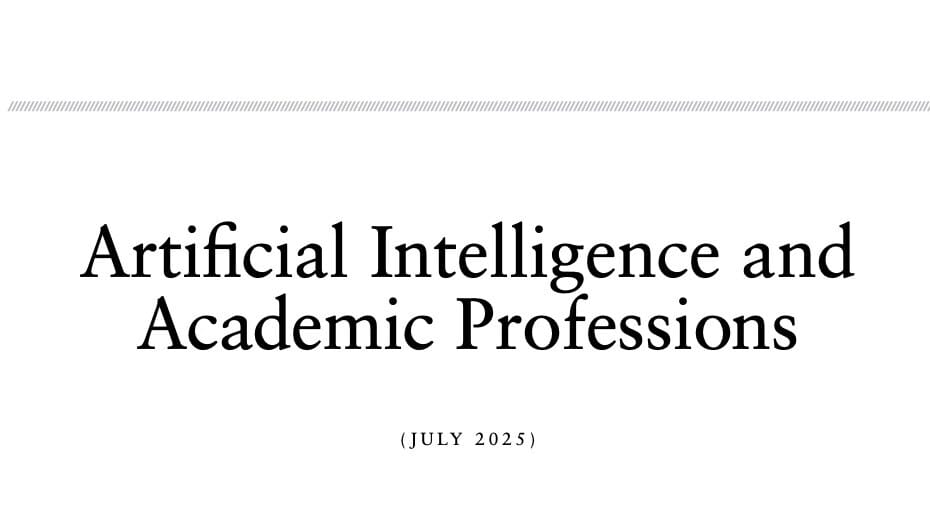- Pascal's Chatbot Q&As
- Posts
- AI in higher education is not inherently negative — but its current trajectory is deeply flawed.
AI in higher education is not inherently negative — but its current trajectory is deeply flawed.
The AAUP’s report offers a democratic, labor-centered vision for AI governance that places the intellectual and ethical mission of higher education at the forefront.
Artificial Intelligence and the Future of Academic Professions — Risks, Responses, and Recommendations
by ChatGPT-4o
The American Association of University Professors (AAUP) has released a compelling report titled Artificial Intelligence and Academic Professions (July 2025), based on a comprehensive survey of 500 members from nearly 200 U.S. campuses. The findings highlight how artificial intelligence (AI) and data-intensive educational technologies (ed-tech) are transforming the academic profession, often without the necessary safeguards, transparency, or participation of faculty and staff. The report is both a critique of current institutional practices and a roadmap for more equitable, responsible AI governance in higher education.
1. AI in Higher Education: Risks and Fractures
The report paints a stark picture: AI is being adopted rapidly and unevenly, often under the guise of innovation and efficiency, without proper understanding of its pedagogical, ethical, and labor implications. Faculty members are frequently mandated to use tools embedded with AI (such as Canvas LMS or Turnitin) without being informed that these tools are AI-enabled. Even more concerning, universities are purchasing and deploying AI tools with little to no shared governance or input from educators, staff, or students.
Moreover, AI is not a panacea. Faculty respondents noted that generative AI can promote shallow learning, misrepresent knowledge, or even be inappropriate for scientific or medical applications. They also raised alarm over AI’s potential for surveillance, dehumanization, job displacement, and erosion of academic freedom and intellectual property rights.
2. Key Findings and Institutional Challenges
AAUP’s survey data revealed five key concerns:
Lack of professional development: Many educators are unaware of the extent to which AI is already embedded in their tools. Without foundational understanding, they cannot evaluate AI’s risks or pedagogical appropriateness.
Governance voids: Over 70% of AI decisions are made unilaterally by administrations, often excluding those most affected — faculty, staff, and students.
Work intensification and inequity: Rather than alleviating workload, AI tools often exacerbate existing labor pressures and reinforce systemic inequalities.
Transparency and opt-out mechanisms: Most institutions lack policies that allow staff or students to meaningfully decline the use of AI tools, even in pedagogical settings where such use may be inappropriate.
Threats to academic labor: Respondents voiced concern about AI-driven deskilling, wage suppression, erosion of job security, and the use of AI analytics in hiring or promotion decisions.
3. The AAUP’s Recommendations
The report presents a detailed, multi-level strategy to address these concerns. These include:
Professional development: Institutions must offer critical, ongoing education on AI, including its embedded use in ed-tech systems and potential harms. Training should not merely focus on tool usage but also on ethical considerations and labor rights.
Shared governance: Every institution should establish an elected ed-tech oversight committee composed of faculty, staff, and students. This body should have real authority over procurement, evaluation, vendor accountability, and data governance.
Human-centered policies: Institutions must prioritize the preservation of academic freedom, privacy, and equitable labor practices. For example, the use of AI analytics in personnel decisions must be transparent, correctable, and challengeable.
Opt-out rights and IP protections: Clear policies must allow educators to opt out of AI tools without penalty and protect instructional materials from being absorbed into training datasets without consent.
Contractual safeguards: Institutions should ensure that AI vendors carry liability insurance and indemnify universities in the case of harms, such as data breaches or algorithmic bias.
These proposals extend to bargaining units, state policymakers, and civil society, pushing for stronger legal frameworks and collective resistance to uncritical AI adoption.
4. Implications for Scholarly Publishers and Other Stakeholders
Scholarly publishers should view this report as a warning and an opportunity. AI’s encroachment into higher education has significant implications for publishing:
Content Use and Licensing: Publishers must proactively establish AI licensing frameworks that prevent unconsented use of educational materials in model training or analytics systems.
Faculty Partnerships: There is a growing need to support faculty in understanding how their authored materials are being used in ed-tech and AI systems. Transparency portals, opt-out mechanisms, and metadata tagging of protected content should be standardized.
Education and Advocacy: Publishers can be valuable allies in pushing for responsible AI integration, supporting initiatives like professional development on AI literacy, and amplifying calls for transparency and accountability in AI procurement.
Ethics and Accessibility: As stewards of the scholarly record, publishers should invest in AI tools that enhance accessibility and equity rather than entrench bias or surveillance. Collaboration with universities on shared governance frameworks for technology could yield mutually beneficial models.
Labor Solidarity: Given the rising threat of deskilling and automation, publishers should build coalitions with academic labor groups to support sustainable, human-centered knowledge ecosystems.
Conclusion
AI in higher education is not inherently negative — but its current trajectory is deeply flawed. The AAUP’s report offers a democratic, labor-centered vision for AI governance that places the intellectual and ethical mission of higher education at the forefront. Scholarly publishers, ed-tech developers, university administrators, policymakers, and faculty unions must heed this call to action. They must work together to ensure that AI augments — rather than undermines — academic integrity, equity, and autonomy.
